Pre-1975 North Indian Ocean cyclone seasons
The years before 1975 featured the pre-1975 North Indian Ocean cyclone seasons. Each season was an ongoing event in the annual cycle of tropical cyclone formation. The North Indian tropical cyclone season has no bounds, but they tend to form between April and December, peaks in May and November. These dates conventionally delimit the period of each year when most tropical cyclones form in the northern Indian Ocean. Below are the most significant cyclones in the time period. Because much of the North Indian coastline is near sea level and prone to flooding, these cyclones can easily kill many with storm surge and flooding. These cyclones are among the deadliest on earth in terms of numbers killed.
1700s
1721 Madras cyclone
It was a cyclone which struck the city of Madras (now Chennai) in the Madras Presidency on 13 and 14 November 1721. The cyclone was one of the most severe in the history of the city and destroyed bridges and even suburban villages. The damages were high and three ships of the British East India Company were lost. The Island Bridge connecting Fort St George with The Island was badly damaged as a result of the cyclone.
1737 Calcutta Cyclone
On 7 October 1737, a natural disaster struck the city of Calcutta (modern-day Kolkata) in India. For a long time this was believed in Europe to have been the result of an earthquake, but it is now believed to have been a tropical cyclone.[1][2] Thomas Joshua Moore, the duties collector for the British East India Company in Calcutta, wrote in his official report that a storm and flood had destroyed nearly all the thatched buildings and killed 3,000 of the city's inhabitants. Other reports from merchant ships indicated an earthquake and tidal surge were to blame, destroying 20,000 ships in the harbor and killing 300,000 people. It should be noted that the population of Calcutta at the time was around 3,000–20,000.[2][3]
Although there seems to be little evidence for the popular figure of 300,000 deaths[4] or for the existence of an earthquake at all, it is this number that shows up in popular literature.[3] At the same time, the figure of 3,000 is only an estimation of the number of deaths inside the city itself.[5] This apparent incongruity in the data suggests a possible mix-up with the numbers for the 1839 Coringa cyclone mentioned in this article, which also suggest 20,000 sunk ships and 300,000 fatalities. Both of these figures may stem from the 300,000 figure in the 1737 super cyclone in the West Bengal region, as neither one has similar numbers, according to the National Cyclone Risk Mitigation Project's site.
December 1789 Indian Cyclone
Strong storm surge from a cyclone that hit Coringa, India destroyed the port and killed 20,000.[6]
Early 1800s
1831 Odisha cyclone
An intense cyclone struck Odisha.[7]
1833 West Bengal cyclone
A ship reported a pressure of 891 mbar (26.30 inHg) at Kedgeree, India.[8]
November 1839 Coringa cyclone
On 25 November 1839, an enormous cyclone caused a 40-foot storm surge that hit Coringa, Andhra Pradesh, wiped out the harbor city, destroyed vessels in its bay, and killed 300,000 people.[6] Survivors never entirely rebuilt the city.
Bengal cyclone of October 1847
This intense cyclone moved into Bengal state. A total of 75,000 people and 6000 cattle perished during the storm.[9]
Late 1800s
1864 Calcutta Cyclone
On October 5, a powerful cyclone hit near Calcutta, India, killing around 60,000 people.[10] The anemometer in the city was blown away during the cyclone. Over 100 brick homes and tens of thousands of tiled and straw huts were leveled. Most ships in the harbor (172 out of 195) were either damaged or destroyed.[11] The cyclone of 1864 destroyed the ports at Khejuri and Hijli.[12]
November 1867 Great Calcutta cyclone
The anemometer in the city was blown away during the cyclone. A lack of storm surge minimized the overall damage from this system.[11]
October 1874 Bengal cyclone
This severe cyclone killed 80,000 people and caused significant damage.[9]
October 1876 Backergunge cyclone
On October 31, a cyclone hit the Meghna River Delta area of India. The storm surge killed 100,000, and the disease after the storm killed another 100,000.[6]
June 1885 Aden cyclone
A cyclone had formed near the Laccadive Islands on May 24, 555 kilometres (345 mi) west of southern India. The SS Mergui encountered the cyclone off the Horn of Africa, 400 kilometres (250 mi) east of Socotra on June 1 and reported it stronger than the tropical cyclone which struck Calcutta in 1864. Just before midnight on the night of June 1, the Diomed reported winds of hurricane force and a pressure of 984 millibars (29.1 inHg). The ship Peshawar reported a westerly hurricane at the east end of the Gulf of Aden towards midnight on the night of June 2. At noon on June 3, the Tantallon reported a pressure of 943 millibars (27.8 inHg) near 12.5N 45.5E. On June 3, the German corvette Augusta, the French dispatch boat Renard, and the British ship SS Speke Hall were lost in the storm in the Gulf of Aden. The system continued westward and shrank in scale as it moved into the entrance of the Red Sea, crossing the coast of Djibouti.[13]
1885 Odisha cyclone
An intense cyclone struck Odisha.[7] it killed one person.
June 1890 Muscat cyclone
This system formed off the west coast of India during the first week of June and moved northwest towards the Arabian peninsula. Approaching the Gulf of Oman, strong winds and heavy rains affected Sur during the afternoon on June 4. Rain spread west that evening towards Muscat, where winds increased to hurricane-force from the north-northeast early on June 5. The eye of the storm made landfall at Sohar at dusk on June 5, eventually dissipating well inland. Heavy rains fell at the hospital in Muscat, where 11.24 inches (285 mm) were recorded. This led to flooding which took several hundred lives. Several thousand date trees were uprooted by the storm's winds and carried away by its floods. Several homes were leveled in Muscat and Mutrah. Fifty perished from downing near the coast or being buried by debris. Overall, 727 people lost their lives.[13]
1895 Odisha cyclone
An intense cyclone struck Odisha.[7]
1895 Balochistan cyclone
In 1895, a cyclonic storm hit the Makran coast in Balochistan province in modern-day Pakistan.[14]
Early 1900s
May 1902 Karachi cyclone
In May 1902, a cyclonic storm struck the coast in the vicinity of Karachi.[14]
June 1907 Karachi cyclone
In June 1907, a tropical storm struck the coast near Karachi.[15]
October 1942 Bengal cyclone
On October 16, a cyclone hit near the India/Bangladesh border, resulting in around 40,000 fatalities.[6] A wind gust of 225 km/h (140 mph) was recorded.
July 1944 Karachi cyclone
On 27 July 1944, a cyclone left some 20,000 people homeless in Karachi.[16]
November 1946 Andhra coast cyclone
This significant storm killed 750 people and led to a loss of 30,000 cattle.[9]
1948 Balochistan cyclone
In 1948, a tropical storm made landfall along the Makran coast in Balochistan province in Pakistan.[14][17]
1950s
Tropical Depression Vae
Typhoon Vae crossed over into the Indian Ocean in 1952.
June 1956 India cyclone
This cyclone brought torrential rainfall to Midnapore district in West Bengal. About 20,000 people were left homeless, while another 20,000 people were left stranded near the Assam border after the Haora River topped its banks. There was an estimated 480 fatalities, most caused by landslides.[18]
December 1957 cyclone
A cyclone developed over the Arabian Sea near the Gulf of Oman on December 27. Moving westward, the storm lashed Bahrain with winds of 110 mph (180 km/h). An offshore oil rig collapsed, killing 20 Royal Dutch Shell employees.[18]
February 1959 cyclone
A cyclone originating over the Arabian Sea left 500 fatalities in Bahrain.[18]
May 1959 Salalah cyclone
This system first became a low-pressure area near the Laccadive Islands on May 19, tracking northwest towards the Arabian peninsula. The system made landfall at Raysut on May 24. At Salalah, skies clouded over on May 23 as the pressure fell significantly. Winds turned northerly before midnight that night. At 1 a.m. on May 24 the peak of the storm's winds arrived. Maximum sustained winds were estimated at 70 knots (130 km/h) and the pressure at Salalaha fell to 968 millibars (28.6 inHg). Many vessels offshore, including two large passenger ships, went to pieces. Five buildings collapsed and several roofs were blown away by the cyclone. Salalah recorded 82 millimetres (3.2 in) of rain at their airport. A total of 141 lives from the ship Samha were taken during this tempest.[13]
1960s
1960
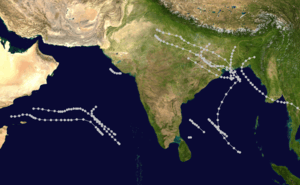
Fifteen depressions developed during the course of the 1960 season, with five becoming cyclonic storms. The majority of activity took place in the Bay of Bengal, with eleven cyclones forming there. The season's first storm formed over the Arabian Sea on May 10. Though it remained over water for its entire existence, several vessels encountered the storm and reported hurricane-force winds as well as a pressure of 974 mbar (hPa; 28.77 inHg). The deadliest and most intense cyclone of the season was Severe Cyclonic Storm Ten, which killed 14,174 in East Pakistan in early November. Attaining peak winds estimated at 150 km/h (90 mph) and a pressure of 966.7 mbar (hPa; 28.55 inHg), it struck just three weeks after the previous system devastated the same area. Producing a 6.1 m (20 ft) storm tide that swept 16 km (10 mi) inland, several coastal islands were completely submerged. An estimated 200,000–300,000 were left homeless in the wake of the two storms. These systems marked the start of an unusually active period of cyclones impacting East Pakistan, culminating ten years later with the 1970 Bhola cyclone that killed 300,000–500,000 people. During the course of the season, several depressions impacted India, each producing heavy rain. Collectively, these systems killed 125 people.
1961
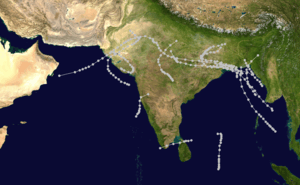
1962
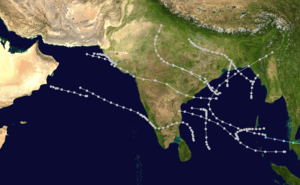
1963
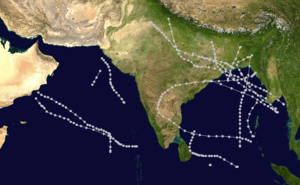
- May Salalah cyclone
On May 19, a tropical disturbance formed over the Laccadive Islands, before tracking northwest towards the Arabian peninsula. The system achieved cyclone intensity on May 22. A United States Weather Bureau research flight flew into the 12 nautical miles (22 km)-wide eye of the hurricane-strength system, and found a central pressure of 947 millibars (28.0 inHg). A ship 111 kilometres (69 mi) west of the system reported winds of 68 knots (126 km/h). At Salalah, a strong northerly wind set in during the morning of May 25. Later in the day, winds increased to gale force and a sandstorm reduced visibility to 400 metres (1,300 ft). Later in the day of May 26 winds again increased to gale force and another sandstorm reduced visibility to 500 metres (1,600 ft). As winds increased to 60 knots (110 km/h) the sandstorm became more severe, with visibility restricted to 50 metres (160 ft). Late on the night of the 26th, winds shifted to northeast and heavy rains fell across the region through the morning hours. Skies remained cloudy with periods of rain into May 28. A total of 230 millimetres (9.1 in) was recorded at Salalah.[13]
- May East Pakistan II cyclone
On May 28, a cyclone hit present-day Bangladesh (then known as East Pakistan province), causing 22,000 fatalities due to storm surge and flooding.[19]
1964
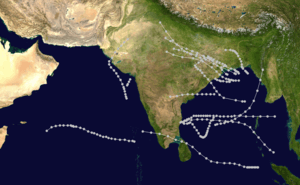
Indus valley cyclone
It made landfall in Tharparkar and Hyderabad district in Sindh province in Pakistan on 12 June.[14][20] However it caused a great loss of life and property in the province.[14] It killed 450 people and left some 400,000 people homeless.[16]
Ceylon cyclone
1965 Bengal Cyclones
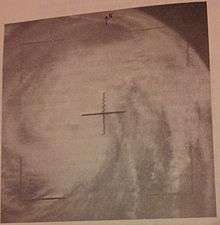
Two cyclones that hit on May 11 and June 1 killed a total of 47,000 people.
December 1965 East Pakistan cyclone
A cyclone hit East Pakistan on December 15, causing about 10,000 casualties.[21]
November 1966 Madras cyclone

A cyclone struck Madras, India on November 3, killing over 50 people and leaving 800,000 people homeless.[22]
October 1967 Odisha cyclone
On October 12, an intense cyclone struck the state of Odisha and left complete devastation along its path.[6]
1968 Myanmar cyclone
On May 10, a cyclone struck Myanmar (then known as Burma), killing 1,037 people and leaving 297,768 people homeless.[23]
1969
Storms in May and November struck Andhra Pradesh, killing 858 people.[24]
1970
1970 Bhola cyclone
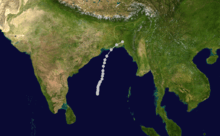
The 1970 Bhola cyclone was a devastating tropical cyclone that struck East Pakistan (now Bangladesh) and India's West Bengal on November 12, 1970. It was the deadliest tropical cyclone ever recorded, and one of the deadliest natural disasters in modern times.[25] Up to 500,000 people lost their lives in the storm, primarily as a result of the storm surge that flooded much of the low-lying islands of the Ganges Delta. This cyclone was the sixth cyclonic storm of the 1970 North Indian Ocean cyclone season, and also the season's strongest, reaching a strength equivalent to a Category 3 hurricane.
The cyclone formed over the central Bay of Bengal on November 8 and travelled north, intensifying as it did so. It reached its peak with winds of 185 km/h (115 mph) on November 12, and made landfall on the coast of East Pakistan that night. The storm surge devastated many of the offshore islands, wiping out villages and destroying crops throughout the region. In the most severely affected Thana, Tazumuddin, over 45% of the population of 167,000 was killed by the storm.
The Pakistani government was severely criticized for its handling of the relief operations following the storm, both by local political leaders in East Pakistan and in the international media. The opposition Awami League gained a landslide victory in the province, and continuing unrest between East Pakistan and the central government triggered the Bangladesh Liberation War, which concluded with the creation of the country of Bangladesh.
1971
1971 Arabian Ocean Cyclone
| Category 1 tropical cyclone (SSHWS) | |
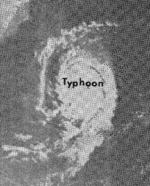 | |
| Duration | October 27 – October 31 |
|---|---|
| Peak intensity | 120 km/h (75 mph) (1-min) |
A tropical cyclone moved through the Arabian Sea near the end of October.
1971 Odisha cyclone
| Category 3 tropical cyclone (SSHWS) | |
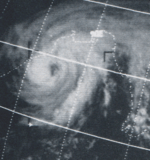  | |
| Duration | October 27 – October 31 |
|---|---|
| Peak intensity | 185 km/h (115 mph) (1-min) |
On October 27 a tropical depression formed in the Bay of Bengal. It tracked northward, steadily strengthening until reaching a peak of 115 mph winds. The cyclone struck Cuttack, a city in Odisha, India, on October 29, and dissipated 2 days later. The storm surge and flooding from the system caused 10,800 fatalities.[26]
1972
A cyclone in September 1972 struck Andhra Pradesh, killing 100.[24]
December 1972 Tamil Nadu cyclone

This system killed 80 people and 150 cattle.[9] The cyclone is visible on The Blue Marble photo taken by Apollo 17.
1973
May 1973 Arabian cyclone
| Tropical storm (SSHWS) | |
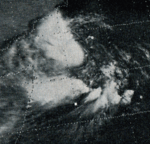 | |
| Duration | May 27 – May 29 |
|---|---|
| Peak intensity | 65 km/h (40 mph) (1-min) |
This system formed in the Arabian Sea on May 27 and struck the Arabian peninsula on May 28, becoming the tenth system to affect the region since 1891.[27]
June 1973 Arabian cyclone
| Tropical storm (SSHWS) | |
 | |
| Duration | June 6 – June 12 |
|---|---|
| Peak intensity | 65 km/h (40 mph) (1-min) |
October 1973 Bay of Bengal cyclone
| Tropical storm (SSHWS) | |
 | |
| Duration | October 6 – October 12 |
|---|---|
| Peak intensity | 85 km/h (50 mph) (1-min) |
Early November Bay of Bengal cyclone
| Category 1 tropical cyclone (SSHWS) | |
 | |
| Duration | November 3 – November 9 |
|---|---|
| Peak intensity | 140 km/h (85 mph) (1-min) |
Mid November Bay of Bengal cyclone
| Tropical storm (SSHWS) | |
 | |
| Duration | November 14 – November 17 |
|---|---|
| Peak intensity | 100 km/h (65 mph) (1-min) |
December 1973 Bay of Bengal cyclone
| Tropical storm (SSHWS) | |
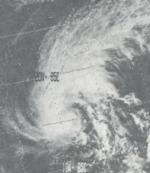 | |
| Duration | December 5 – December 9 |
|---|---|
| Peak intensity | 110 km/h (70 mph) (1-min) |
This system formed as a tropical depression in the southern Bay on December 5, strengthening into a tropical storm as it turned north-northwest on December 5, then to hurricane strength on December 6. The cyclone recurved, striking Indian near Calcutta on December 9, though its main impacts were across Bangladesh.[28]
1974
April 1974 Arabian Sea cyclone

May 1974 Arabian Sea cyclone
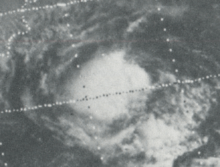
August 1974 Bay of Bengal cyclone
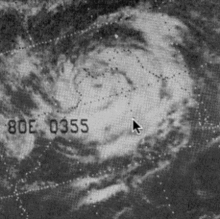
September 21–24, 1974 Arabian Sea cyclone
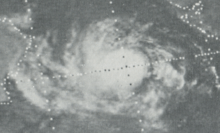
November 23–28, 1974 Bay of Bengal cyclone
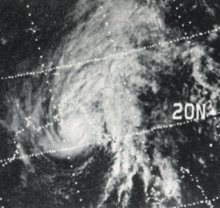
This system developed off the eastern coast of southern India on November 23 and strengthened as it moved to the northeast. The system nearly reached hurricane strength as it made landfall near Chittagong late on November 28. A 10 feet (3.0 m) storm surge accompanied the system's approach to Bangladesh, which inundated several islands offshore. Less than 100 people perished while thousands were left homeless.[29]
See also
- Tropical cyclones and tornadoes in Pakistan
- List of North Indian Ocean cyclone seasons
- List of tropical cyclones that affected India
- List of tropical cyclones
- Tropical cyclone
- Saffir-Simpson Hurricane Scale
- List of Pacific typhoon seasons
- List of Atlantic hurricane seasons
- List of Pacific hurricane seasons
References
- ↑ "Earthquakes with 50,000 or More Deaths". USGS. March 29, 2010. Archived from the original on November 2, 2009. Retrieved 6 June 2010.
- 1 2 Bilham, The 1737 Calcutta Earthquake and Cyclone Evaluated, Bull. Seism. Soc. Amer. 84(5), 1650–1657, 1994.
- 1 2 Quake sleuth 'saves' 300,000 lives.
- ↑ colorado.edu, Background to the 1737 "event"
- ↑ Cyclone Related Disasters Archived October 25, 2005, at the Wayback Machine.
- 1 2 3 4 5 Emergency Disaster Management, Inc. (2003-07-02). "Cyclone". Retrieved 2010-04-15.
- 1 2 3 P. Chittibabu; S. K. Dube; J. B. Macnabb; T. S. Murty; A. D. Rao; U. C. Mohanty; P. C. Sinha (February 2004). "Mitigation of Flooding and Cyclone Hazard in Orissa, India". Natural Hazards. 31 (2): 455–485. doi:10.1023/B:NHAZ.0000023362.26409.22. ISSN 0921-030X. Retrieved 2010-04-15.
- ↑ https://books.google.com/books?id=8kXwskQHBLoC&pg=PA113&lpg=PA113&dq=madagascar+1899+pressure&source=bl&ots=qEKb-I571S&sig=zQUujxd2_ejSJSV4stzbBIi6x2g&hl=en&sa=X&ved=0ahUKEwiRnvGkjKjOAhXj5oMKHX28B_MQ6AEIJDAD#v=onepage&q=madagascar%201899%20pressure&f=false
- 1 2 3 4 Dipankar C. Patnaik & N. Sivagnanam (November 2007). "DISASTER VULNERABILITY OF COASTAL STATES: A Short Case Study of Orissa, India". Social Science Research Network. p. 4. SSRN 1074845. Missing or empty
|url=(help);|access-date=requires|url=(help) - ↑ Gastrell, J. E.; Henry F. Blanford (1866). Report On The Calcutta Cyclone Of The 5th October 1864. Calcutta: Government Of Bengal. Retrieved 2009-08-15.
- 1 2 "Calcutta". 1902 Encyclopedia. 2010. Retrieved 2010-04-15.
- ↑ "Cyclones and floods at Contai (page 4)". contai.info. Archived from the original on 2011-10-03. Retrieved 2011-08-02.
- 1 2 3 4 David Membery (July 2002). "Monsoon Tropical Cyclones: Part 2". Weather. Royal Meteorological Society. 57 (7): 247–255. Bibcode:2002Wthr...57..246M. doi:10.1256/004316502760195911.
- 1 2 3 4 5 Indian Weather Man (IWM): Cyclone History for Karachi
- ↑ http://indianweatherman.blogspot.com/2010/06/cyclone-history-for-karachi.html
- 1 2 "Archived copy" (PDF). Archived from the original (PDF) on 2011-07-09. Retrieved 2010-06-01.
- ↑ "Unisys Weather: 1948 Hurricane/Tropical Data for Northern Indian Ocean". Archived from the original on 2011-07-17. Retrieved 2010-12-22.
- 1 2 3 David Longshore (May 12, 2010). Encyclopedia of Hurricanes, Typhoons, and Cyclones. Infobase Publishing. pp. 113, 258. ISBN 1438118791. Retrieved February 26, 2016.
- ↑ "20th-Century Natural Disasters". Los Angeles Times. 1985-05-28. Retrieved 2010-04-15.
- ↑ "Unisys Weather: 1964 Hurricane/Tropical Data for Northern Indian Ocean". Archived from the original on 2011-07-17. Retrieved 2010-11-28.
- ↑ St. Petersburg Times – Google News Archive Search
- ↑ "On the Editor's Desk". Mariners Weather Log. Environmental Science Services Administrarion. 11 (2): 52. March 1967.
- ↑ http://pdf.usaid.gov/pdf_docs/pnady561.pdf
- 1 2 Technical Annex on a Proposed Loan and Credit to India for an Andhra Pradesh Hazard Mitigation and Emergency Cyclone Recovery Project (PDF) (Report). World Bank. 1997-04-11. p. Attachment 16.
- ↑ "Disaster; East Pakistan: Cyclone May Be The Worst Catastrophe of Century Archived 2013-11-11 at the Wayback Machine." (pay article), The New York Times, November 22, 1970, p. 169.
- ↑ "Natural catastrophes and man-made disasters in 2008: North America and Asia suffer heavy losses" (PDF). Swiss Reinsurance Company Ltd. 21 January 2009. p. 38. Retrieved 23 May 2017.
- ↑ Mariners Weather Log. National Oceanic and Atmospheric Administration. 17 (6): 366. November 1973. Missing or empty
|title=(help) - ↑ Richard M. DeAngelis (March 1974). "Hurricane Alley". Mariners Weather Log. 18 (2): 93.
- ↑ Dick DeAngelis (March 1975). "Hurricane Alley". Mariners Weather Log. National Oceanic and Atmospheric Administration. 19 (2): 88–89.
General references
- "Cyclone, Hurricane, White squall, Typhoon.". The Cyclopaedia of Indian And Of Eastern And Southern Asia: Commercial, Industrial, and Scientific, 3rd Edition. I. London: Bernard Quaritch. 1885. pp. 866–868. Retrieved 2009-08-15.